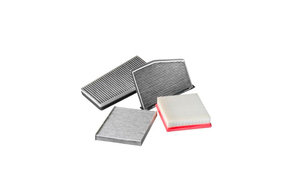Passenger compartment filters
In recent years, the concentration of harmful substances on our roads (dirt particles, dust, tyre debris, soot and pollen, nitrous gases, ozone, hydrocarbons or sulphur dioxide to name but a few) has...
Function
In recent years, the concentration of harmful substances on our roads (dirt particles, dust, tyre debris, soot and pollen, nitrous gases, ozone, hydrocarbons or sulphur dioxide to name but a few) has increased significantly. Levels inside the vehicle can be significantly higher again than they are in ambient air. This is because the fans for the fresh air supply or in the air conditioning system suck in polluted air like a vacuum and distribute it inside the vehicle.

To avoid this, modern vehicles are fitted with passenger compartment filters. These filters remove all harmful substances from the ambient air, supplying the interior with clean air. Passenger compartment filters must be capable of performing effectively and creating the conditions for comfortable travel even in extreme weather conditions (winter or summer), when pollen counts are high, in heavy traffic, in tunnels, on sections of road where work is taking place or in traffic jams.
Variants of passenger compartment filters
There are two types of passenger compartment filter design, particle filters and combination filters. Particle filters Particle filters are designed to absorb particulate impurities from road air so that the air flowing into the vehicle is clean. Air-borne particulate impurities vary in size and come from numerous sources. They occur as liquids and solids, e.g. in the form of pollen, road dust, debris from brakes, tyres or the clutch, as soot or industrial dust. In a particle filter, the filter medium (sometimes also referred to as filter paper) is folded to form a zigzag shape. It is made from high-performance synthetic fleece which is usually electrostatically charged. Separation is either mechanical or electrostatic. Mechanical separation is achieved by means of the multi-layer fleece structure, which resembles a cobweb. The particles from the air stick to the fine fibres of the structure when the air flows through the filter. With electrostatic charging, even the tiniest particles (< 5 µm) can be separated. The functional principle is similar to that of a magnet. The static pull of the fibres separates small particles from the air. High-quality particle filters use this technique to filter almost 100% of dust and particles out of the air. Combined filters Combined filters benefit from of the performance features of particle filters plus an active carbon layer. As such, in addition to dust and particles, combined filters are even able to filter odours and harmful gases such as benzene or ozone out of the ambient air. The open-pore surface of the special active carbon absorbs odour and gas molecules from the air like a sponge and stores them in labyrinth-like channels. A teaspoonful of active carbon will cover an area equivalent to the size of a football field. The combined filter is thus able to filter a significant amount of air. However, this capacity will reach its limits at some point. For optimum performance, combined filters should be replaced at recommended intervals.
Changing the filters
However, the performance of a passenger compartment filter declines over time. The higher the levels of dust, the more clogged the filter becomes. A "filter cake" forms between the individual pleats, preventing air from flowing through. Therefore, it is important to replace passenger compartment filters regularly – ideally every 15,000 kilometres but at least once a year.
Safety
A passenger compartment filter is most valuable at damp and cold times of the year. A functioning passenger compartment filter in original equipment quality will protect against misting during these times. It will also stop dust, soot and other deposits forming a lubricating film covering the inside of the car windows, thereby ensuring good visibility at all times. In spring and summer, the passenger compartment filter represses pollen virtually 100%. This creates a fresh air safety cell inside the vehicle, giving allergy sufferers a pollen-free zone and thus improving their quality of life. The active carbon filter also stops harmful exhaust gases and unpleasant odours getting into the passenger compartment. These can often trigger tiredness, headaches or even irritation. Stop-and-go traffic or driving through tunnels almost go unnoticed with a functioning combination filter. All of these properties combined with better ventilation improve drivers' concentration and awareness in daily traffic and thus increase not only their own safety but also the safety of other road users.
Depreciation
By repressing dirt particles, the passenger compartment filter actively helps the vehicle to retain value. Dirt deposits which would otherwise float around inside the passenger compartment are unable to settle on upholstery, roof linings and many other components. Passenger compartment filters also protect heating and air conditioning systems, as they ensure that only cleaned air can access their heat exchangers. This helps to maximise their service life. Passenger compartment filters are often overlooked during inspection or maintenance work, as they are relatively new to the market. Therefore, drivers and owners should ensure that they are replaced regularly.
Environmental protection
Although the passenger compartment is the primary beneficiary of the cleaning function of the passenger compartment filter, it is not the only beneficiary. Having been cleaned of soot, debris, ozone, benzene, fine dust and other particles, the air escapes back into the environment. As such the passenger compartment filter also helps to improve general air quality. Furthermore, drivers can save fuel by replacing the passenger compartment filter at the specified intervals. After all, the better the air throughput of the heating or air conditioning system, the less time and thus fuel the engine needs to warm up or cool down the air inside the passenger compartment. Less fuel also means fewer harmful CO2 emissions and a reduction in the consumption of energy resources.















